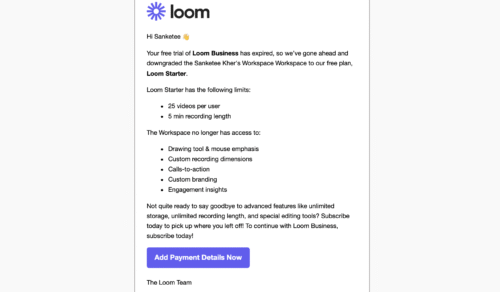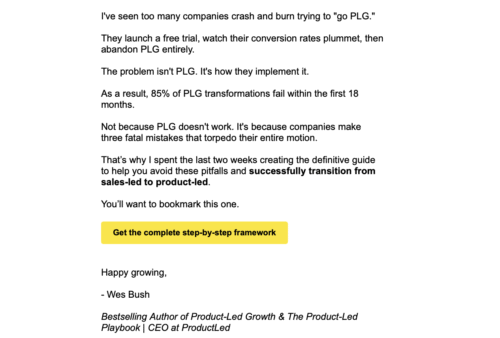These days, most inboxes are flooded with promotional emails, but attention spans are shrinking. It could mean that people aren’t just skimming your emails; they’re probably skipping them entirely.
The truth? Audiences want value, not noise.
With 4.48 billion email users globally and the average email marketing budget being 7.8% of the total marketing spend, you can’t afford to take a shot in the dark.
One great way to stand out is by adding a clear intention. This could be through copy, design, and messaging that mirrors your audience’s mindset.
This is where following content marketing trends for email becomes your cheat sheet. Understanding what people actually want from brands today helps you create emails that are remembered.
Let’s look at what these might be.
7 Content Marketing Trends For Email Marketing
1. Prioritize authenticity over polished content
Gone are the days when slick, overly polished corporate emails flooded the inbox.
Today’s readers crave authenticity. Basically, they’re looking for messages that sound like they’re written by a human, not a committee. This shift reflects a broader evolution in content marketing: people are tired of being sold to. They must feel like they’re in a conversation, not a campaign. This shift is a clear signal for brands to invest in content marketing approaches that prioritize real conversations over rigid messaging.
That’s why a conversational tone often outperforms formal or salesy copy. It invites the reader in. Think contractions, first-person language, and even a bit of tasteful humor.
It’s not about being casual for the sake of it. Instead, it’s about creating a genuine connection. A warm, “Hey, here’s something we thought you’d love” feels far more approachable than “We are pleased to announce our latest offering.”
Take Duolingo, for example. Their emails are quirky, self-aware, and lean into their playful brand voice. A cheeky subject line like “Your French skills are getting moldy” combined with their owl mascot, Duo, reinforces their fun tone and keeps users coming back. It may not be like a typical business email, but it sure is packed with personality.
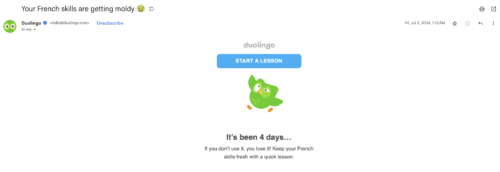
The result? Higher engagement, better brand recall, and an audience that’s bound to return to their app.
Don’t just take it from us; look at this recent X post that shows their followers are in on the cheeky humor:
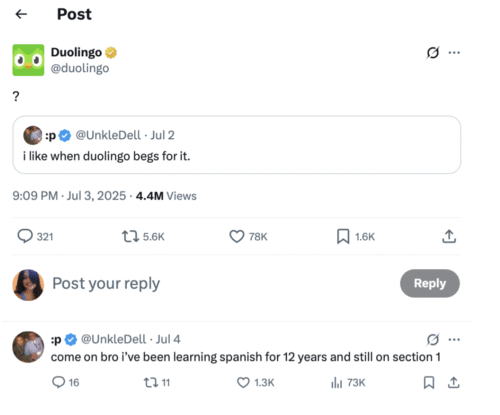
2. Visual-first content can win attention
Did you ever stop scrolling just to read a huge chunk of text? The answer would certainly be no.
But a standout image, playful GIF, or behind-the-scenes content would have definitely caught your attention.
That’s why visual-first content isn’t simply a nice-to-have. It’s a necessity. Current content marketing trends show that visuals are super effective. According to GetResponse, these stats emphasize the importance of using visuals:
- Images get a 30.27% open rate and a CTR of 2.78%
- 58% marketers use GIFs in emails, and 43% shared that they got better results because of it
- Videos can get you up to a 75% CTR
It’s probably because media helps communicate ideas faster, breaks up long copy, and makes emails feel more engaging. They’re especially effective when the product or concept needs a bit of explaining.
Even playful elements like memes or brand-themed illustrations help inject personality while reinforcing brand recognition. But remember, whether it’s guiding attention, reinforcing a CTA, or making the content more skimmable, every visual should have a purpose.
Take Printful, a print-on-demand company, for example. Their emails are a masterclass in visual storytelling. Instead of overexplaining how their service works, they use clean graphics to walk users through the journey.

They even link to helpful pages like services and blogs. So, if a new user wants to understand what is print on demand or the best-selling T-shirt designs in 2025, they can easily get clarity.
3. Offer personalized experiences for higher conversions
Let’s agree that personalization isn’t about inserting a first name anymore. Content marketing trends reveal that you must show your audience that you truly understand them. The most impactful emails today go far beyond demographics like age or industry. Instead, they use behavior-based segmentation to tailor messages to where a person is in their journey, i.e., hyper-personalization.
- If someone clicked a product link but didn’t purchase, send a reminder with that specific product.
- If they’ve downloaded a whitepaper, offer related resources next.
Such dynamic, action-based content is what creates relevant, timely experiences and eventually boosts conversions.
For example, referencing a customer’s last order, celebrating a signup anniversary, or sending content tailored to their preferences shows that your brand is paying attention. Take a cue from Loom’s email below:
They send out a follow-up email when a user’s free trial runs out so they may upgrade their services and continue using the platform without any hiccup. And when your emails feel like it was written for them, your audience is far more likely to engage and repeatedly convert.
To consistently create this level of personalization, marketing teams need to work closely with product, sales, and support to align on customer insights. But without a centralized system to store and share knowledge, efforts can feel disjointed. That’s where you can employ learning content management systems to help your training materials, product updates, and messaging guidelines stay in one place, making your campaigns cohesive.
4. Focus on short-form storytelling with emotional hooks
Hooks incite emotions, and emotions lead to action. That’s why, when planning your email campaign, lead with an emotion, a relatable insight, or a quick problem-solution setup.
Think of it like a punchy headline followed by a satisfying payoff. Instead of dumping details, show; don’t tell. A well-placed anecdote, a one-liner about a common struggle, or even a dramatic stat can create enough intrigue to make the reader want to click.
Wes Bush does this brilliantly. The emails are well-timed, have direct subject lines — transition from sales-led to PLG (safely), a short, helpful body, and a single, clear CTA. No fluff.
He begins the email with a personal story and gradually transitions to explaining the solutions. Finally, inserts a CTA that’s bound to get clicked. This kind of short-form storytelling builds trust and feels personal and compelling. Remember, it’s not about cramming in more words. Instead, it’s a lesson in using fewer words that matter more.
5. Ensure mobile-first formatting
Around 55%-65% of emails are opened on mobile devices. Still, many aren’t optimized for small screens. That’s a huge missed opportunity because if your email requires zooming, pinching, or too much scrolling, you’ve probably lost your reader.
That’s why mobile-first formatting is essential. A single-column layout keeps things clean and easy to follow. It prevents broken designs and ensures your message flows naturally, top to bottom, so no awkward side-scrolling is required.
Small touches make a big difference here:
- Tap-friendly buttons
- Readable font sizes (at least 14px for body text)
- Generous spacing between elements helps users interact without frustration
- Easily clickable CTAs
Zoom nails this with beautifully responsive email designs. Whether they’re sending upgrade emails or announcing new features, everything from imagery to buttons feels tailored for a thumb swipe.
Let’s look at what makes their email campaigns work. The screenshot below shows just their logo, a clear headline, and a visible CTA so the reader can focus on what truly matters — upgrading their plan.

Notice how their emails follow one thing consistently — uncluttered designs. This is ideal for emails being opened on mobiles since it reduces distractions and elicits a response.
6. Provide interactive elements to boost engagement rates
Avoid having a one-way monologue while creating email copy. To turn passive readers into active participants, you must add interactive elements to your emails.
Simple additions like polls, quizzes, or embedded videos invite users to click, explore, and even share. Whether it’s a “Which style suits you best?” quiz or a quick product demo, interactivity makes emails feel less like announcements and more like experiences.
One such example is Crunchbase.
Their recommendation emails often include interactive content like clickable headings and quick company previews right inside the message. This helps users find relevant recommendations without ever leaving their inbox.
Another effective tool? Countdown timers. These work wonders for sales or limited-time events, adding urgency without sounding pushy. When time is literally ticking, people are more likely to act.
Here’s a sign-up email from Miro:
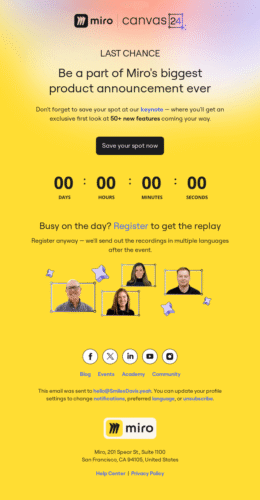
They added a few CTAs to help seal the deal, like save your spot now and register.
7. Align tone with the audience’s mood
The wrong tone can ruin the right message. Whether you’re announcing a product, sharing an update, or just saying hi, how you say it matters as much as what you’re saying.
An empathetic tone that acknowledges your reader’s mindset feels more human and relatable. It shows that you’re not just broadcasting, but actually listening. Especially during uncertain times or high-stress periods, softer, more supportive language performs better than hard sells or forced excitement.
And let’s be real: whatever content marketing trends are “in” at the moment, audiences can smell jargon and clichés from a mile away. Phrases like “innovative solutions” or “unprecedented value” rarely mean anything to the person reading them. That’s why focusing on clarity and honesty is paramount. You have to speak like a real person would.
Grammarly does this beautifully. Their emails strike a warm, thoughtful tone, offering encouragement rather than pressure. It’s the kind of tone that builds trust, not just clicks.
Take this email as an example. Who doesn’t like a huge discount? Grammarly tackles it while showing what’s in it for the customers by showing the difference between the free and premium plan:
So, even if you have all your design and formatting in place, addressing the mood in the right tone without being pushy is key.
Content Marketing Trends: Conclusion
Creating email content that connects isn’t about chasing every trend; it’s about choosing the ones that help you create more intentional, engaging emails. Whether you’re nurturing leads or reaching out to dormant subscribers, thoughtful content marketing makes all the difference.
Keep these in mind:
- Content marketing trends are tools that should enhance, not distract
- The best emails feel tailored and not like templates
- Great design and copy should work in tandem
Finally, test what resonates and tweak your strategy accordingly.

